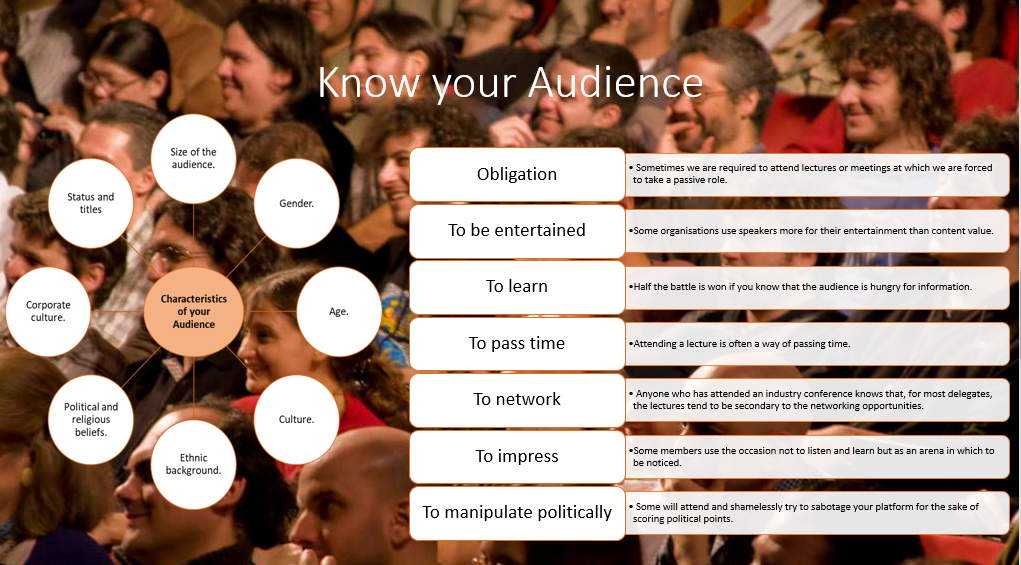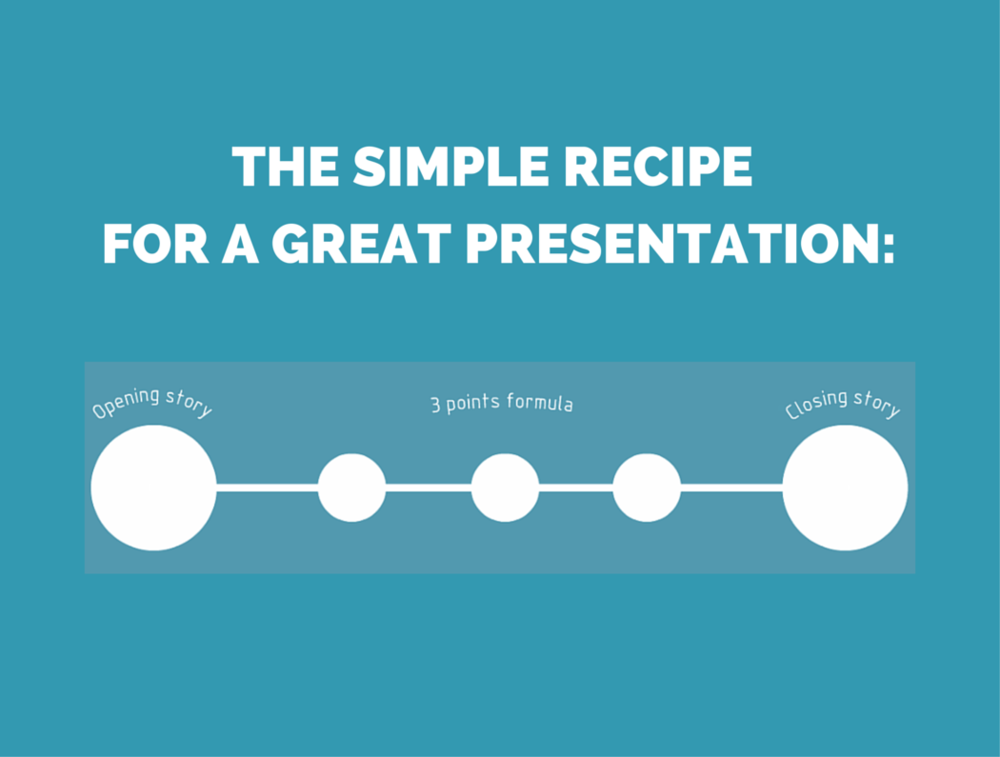Step 1- Identifying Your Own Objectives
If you are not clear about what you want to accomplish with your presentation, you are guaranteed to produce a vague and embarrassingly inept performance. Define what you want your audience to do as a result of your presentation. There are five main purposes for the presentation.
Persuading: influencing opinions/urging people to adopt a certain line of action
Challenging: reveal what people must face up to/dare to do
Informing: update people with news/facts
Teaching: Training or coaching, giving instruction
Giving bad news: reveal bad news
...yet, your objective will still be that they do something as a result of attending the presentation. Specifically, what do you want to achieve?
Try to narrow down your objective to one single strong sentence – that spells out exactly what it is that you want to achieve.
Step 2 - Identifying Your Audience's Objectives
For this, try and get inside the mind of your audience.
It appears that a large crowd of people packed together in one place achieves two important results that still cannot be so well achieved by any other means: the affirmation of unity and solidarity, and the acclamation of leadership. This is not true of small gatherings, but as they grow larger it becomes more and more true. A really large audience is not, for most practical purposes, a place for detailed and reasoned arguments. The more people there are, the smaller the proportion whose knowledge, experience, intelligence and interest are at the right level, and the harder it is for the argument to be comprehensible and relevant to any but a few. So, you have to appeal not to the diverse minds but to the common emotions – hopes and fears, elation and aggression, admiration and contempt, shared experiences and shared aspirations.
When you get so many people together, you are not dealing with the intellectual differences of the individual but with the biological identity of the species. In an audience, we discover our group identity and we accord special prominence and respect to those who lead us to the discovery.
In order to pitch your presentation at the right level and to establish the appropriate language level, you need to identify the type of audience that you will be addressing. Can you speak in a language that is understood by the audience? This is a question you should ask yourself before every lecture. Audience language means- ‘words that the audience use and understands’.
If your audience prefers pictures and simple language, give them exactly that. Other audiences, are familiar with technical words, so pitch your lecture at their level of understanding otherwise they may think you are insulting their intelligence.
The characteristics of the audience are extremely important. And so is their motivation for being there.

Finally, you should be able to formulate another key sentence – the one which expresses the final impression you want to leave in the mind of your audience when the presentation ends.
Click here to find a guideline that you can use to prepare a presentation well so it fulfils your purpose as well as meet the expectations of the audience.
Step 3 - Plan for the Duration of the Presentation
A lecturer may ask himself “how long does the subject need to last?”, but a presenter needs to ask “How long can the audience spare?” Most people are worried that they will not have enough to say. There seems to be some sort of guilt about giving short measures. Consequently, the great danger at this stage is of having too much to say. In planning it could be helpful to mark the paragraphs of your script with A, B, and C in terms of importance. Should your time run out you can easily cut the “C” paragraphs without sacrificing critical content. In planning your time keep in mind that the use of visual aids will “spread” your timing.
A presentation that runs too long upsets everybody. Should you not plan correctly, and your presentation is too long, you will find yourself going too fast, cutting on interesting, but less essential parts and consequently making the whole presentation more indigestible.
Step 4 - Select a Presentation Technique most Applicable to the Specific Type of Presentation
A lecturer should not rely on a sole method of instruction. A well-structured lecture would have more than one method of delivery. Remember that variety is necessary, but don’t go overboard.
A Presenter on the other hand should not use more than two methods / techniques for presentation as this could confuse the audience and take up too much time.
The experienced lecturer/ presenter will be able to look at a topic and decide on a number of methods that can be used independently, or in combination, for maximum benefit to the delegate.
The presenter must make the decision on which method to use of instructions based on the delegate’s requirements and not on what the presenter feels like doing.
Click on the link/s below to open the resources.
Step 5 - Prepare the Script of the Presentation
When faced with the task of giving a presentation, the first step you need to take in your preparation is to do research. Whether you are an expert in the subject or know only a little about it, you need to do some research to come up with the right material for your lecture.
Researching Involves:
- Identifying sources of information
- Going to the library
- Meeting people
- Watching videos
- Listening to tapes
- Reading reports
- Internet
Before starting the research, consider the following points:
- How much do I know about the subject?
- Who is the audience?
- What is the time allocated?
- Decide on the content
Script according to the type of presentation you wish to do.
Preparation of the script will differ –depending on the type of presentation that you intend to do.
Click here to view a video that explains the different types of presentations, and how you could adapt your script accordingly.
Writing the Script
Don’t try to achieve perfection, because you may never be satisfied with any of the results and end up spending more time than you anticipated without achieving the goals. However, this should not be an excuse for a poor presentation. Do make sure that you have some extra time available in your schedule for last-minute changes such as a new idea, which may come to light after you’ve written your script.
Now that you know what to include, it is time to start writing a script for your presentation. You may decide to read the script or memorise it, depending on your skills and abilities. Whatever you choose to do, it is very important to write a script – when writing something down, it is easier for you to establish your weaknesses or mistakes and try to correct them. Having a script helps you avoid improvising in your lecture, which is a dangerous risk to take as a presenter, experienced or not.
When all the changes are complete, you will have the final script of your presentation. It is now up to you to familiarise yourself with the script and learn it by heart if you are intending to give the lecture as a talk with cue cards. Whatever you decide to do, try to be as natural as possible when you are presenting. Now the words are ready, it is time to back them up with some pictures, posters or slides.
A presentation plan is an essential piece of equipment for the presenter. It serves to guide you in the correct sequence and ensures that all relevant material is covered during the presentation.
It provides a check to see if objectives are being met, if relevant. It can be checked by others to see if the lecture plan and objectives are both working in the same direction and not against each other.
Click on the link/s below to open the resources.
Critical Considerations To Keep In Mind When Planning Your Script

Introduction of Your Presentation
Now that you know what your presentation is about, you are in a position to introduce and conclude it!
In your introduction, you have to grab the interest and attention of your audience. (You should also try to space out additional attention-getters approximately every 10 minutes in the body of your presentation in order to keep both interest and your listeners alive.) The fact is that every speaker needs some sort of acceptance from the audience: if they are to accept what you say, they need some grounds for believing that you in most ways the same sort of person as them and that you will present new and interesting perspectives/ information on the topic.
Structure your introduction as follow:

Main Ideas
It is also fine to start with the body of the presentation first and do the introduction and conclusion later because, once your ideas are developed, you will know what it is you are introducing and concluding! Keeping in mind what it is you want people to do after your presentation, make a list of important ideas in achieving your objective. Categorise your list into main ideas, others which support them, and ideas which can be discarded. Two to five main ideas will be enough.
Support each main idea with a few supportive comments. These may be explanations, research data, anecdotes or other relevant ideas which add substance and merit to the main ideas.
You are telling your audience a story, and it is important to repeat the main points, for them to remember, throughout the lecture. Use the following guidelines:
- Every point must have a clear beginning, middle and end to it.
- Smooth transition from one point to the next.
- Audiences will absorb a limited amount of information, don’t data overload.
- Jokes must be highly relevant.
- Avoid the use of unnecessary words.
- Phrase your ideas in the form of questions.
- Use appropriate analogies and things of an interesting nature.
- Maintain a level of energy and enthusiasm.
- Summarise regularly.
- Fit contents within the allocated time.
The Conclusion
Your conclusion must not introduce new material or ideas. It is a wrap-up of what has gone before – the same ideas but perhaps expressed in different words.
Hillaire Belloc’s famous words apply: Tell them what you’re going to tell them, then tell them, and then tell them that you’ve told them.
It must clearly summarise the main argument, reinforce the benefits and remind your audience of the first step of the action plan. Try to find a punchy ending for your closing words.
Your closing will include the conclusion, that is, the summary of your argument. However, try to find an inspiring, challenging or moving phrase or sentence as a last thought which also encapsulates whatever it is you originally wanted people to do as a result of attending your presentation.
Hold the silence after your last word, without stepping down or away. Wait for and enjoy the applause and acknowledge it with a simple: Thank you.
Don’t bow, even though you may experience a peculiar desire to do so!
Step 6 - Decide on and Prepare the Accompanying Material
All presenters must realise that if the same aids or none are used all the time, it can build a barrier to transmitting the message. The specific aid should also complement the objective of the presentation. Many types of presentation media are available. Frequently, the choice should not simply be which one to select but which ones to select.
Click on the link/s below to open the resources.
Different Kind Of Resources That You Can Use To Support Your Presentation